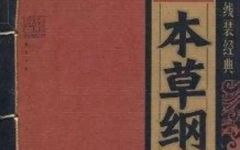Compendium of Materia Medica
The Compendium of Materia Medica (Bencao Gangmu) was named by Li Shizhen, borrowing the title from Zhu Xi’s Comprehensive Mirror for Aid in Government (Tongjian Gangmu). He began compiling it in the 31st year of the Jiajing era (1552) and completed it after three revisions in the 6th year of the Wanli era (1578), taking a total of 27 years.
The Compendium of Materia Medica consists of 16 sections and 52 volumes, totaling approximately 1.9 million words. The book includes 1,518 medicinal substances from various sources, adding 374 new substances to the previous works, making a total of 1,892 substances, of which 1,195 are plants. It also compiles 11,096 ancient prescriptions and folk remedies. This great work absorbs the essence of past materia medica writings, corrects previous errors, supplements deficiencies, and includes many important discoveries and breakthroughs. It is the most systematic, complete, and scientific medical work in China up to the 16th century.
Li Shizhen broke the long-standing classification system of upper, middle, and lower grades that had been in place since the Shennong Bencao Jing for over a thousand years, categorizing medicinal substances into 16 sections based on water, fire, earth, metal, stone, grass, grains, vegetables, fruits, wood, utensils, insects, scales, shells, birds, beasts, and humans, including 60 categories. Each medicinal substance is accurately named as a category, with clear subcategories. The book systematically records knowledge about various medicinal substances, including corrections, explanations, collections, verifications, modifications, flavors, main uses, inventions, appendices, and additional prescriptions, detailing the history, morphology, and functions of the substances, enriching the knowledge of materia medica.
According to research by Mr. Ma Yuanjun, Li Shizhen’s classification method in botany is a systematic approach that categorizes plants based on practical uses and morphological similarities, classifying them into various categories and hierarchically organizing them. Li Shizhen classified over a thousand plants based on their economic uses, morphology, habits, and internal contents, first grouping similar substances into five sections (grass, eye, vegetable, fruit, and grain as categories), which are further divided into 30 categories (for example, 9 categories for grass, 6 for wood, and 7 each for vegetables and fruits, with 5 for grains as subcategories), and then subdivided into several species. This not only indicates the genetic relationships between plants but also standardizes many naming conventions for plants.
The Compendium of Materia Medica has made significant contributions to the development of Chinese pharmacology and has had a profound impact on the development of world medicine, botany, zoology, mineralogy, and chemistry. It has been translated into more than ten languages, including Japanese, French, German, English, Latin, Russian, and Korean, and published abroad. The book pioneered a systematic classification of medicinal substances based on their natural properties, a method that is one of the important methods in modern biological classification, predating Linnaeus’s Systema Naturae by a century and a half, earning it the title of “Great Classic of Eastern Medicine.” In May 2011, the Jinling edition of the Compendium of Materia Medica was included in the World Memory Register.

